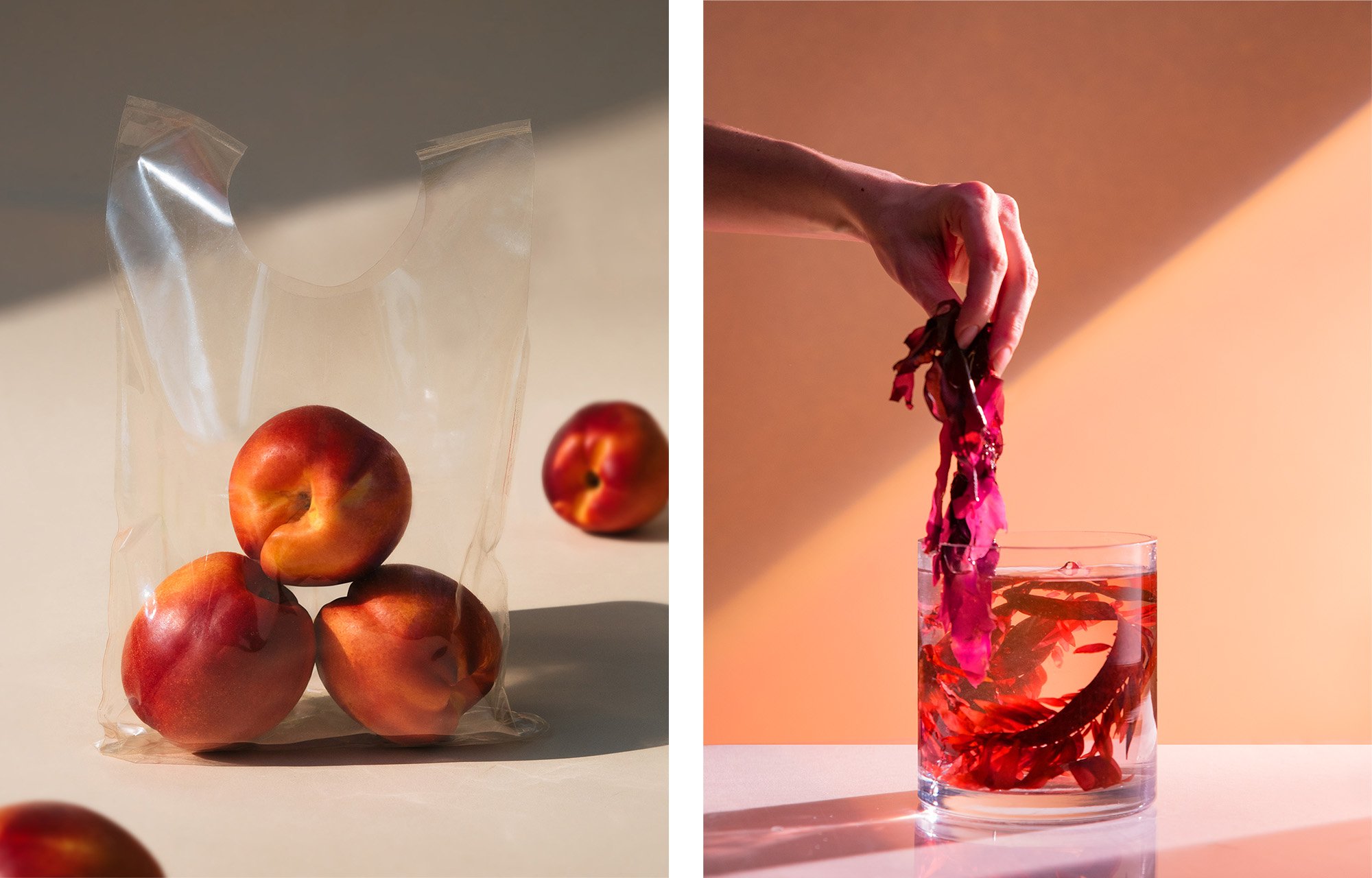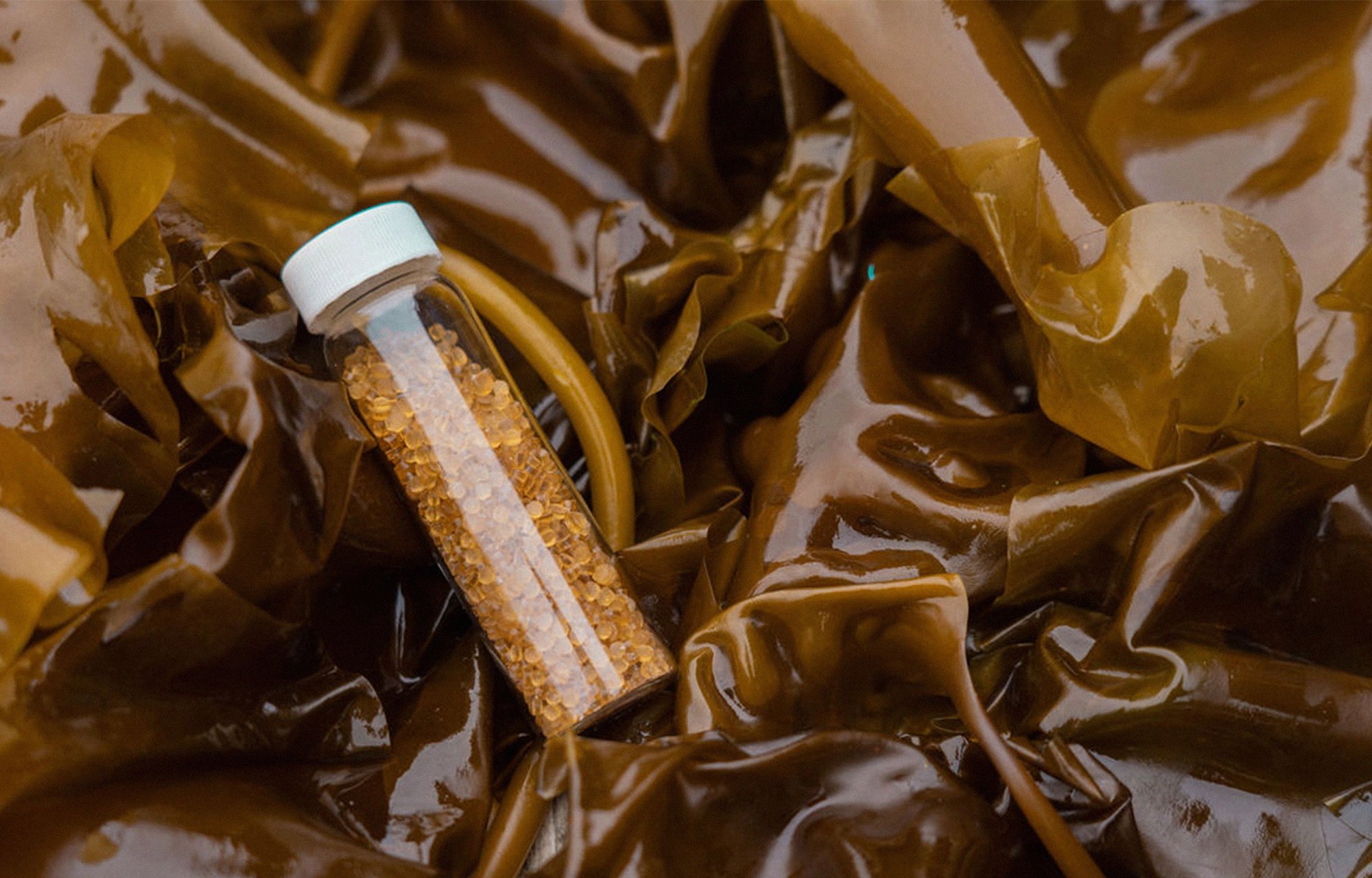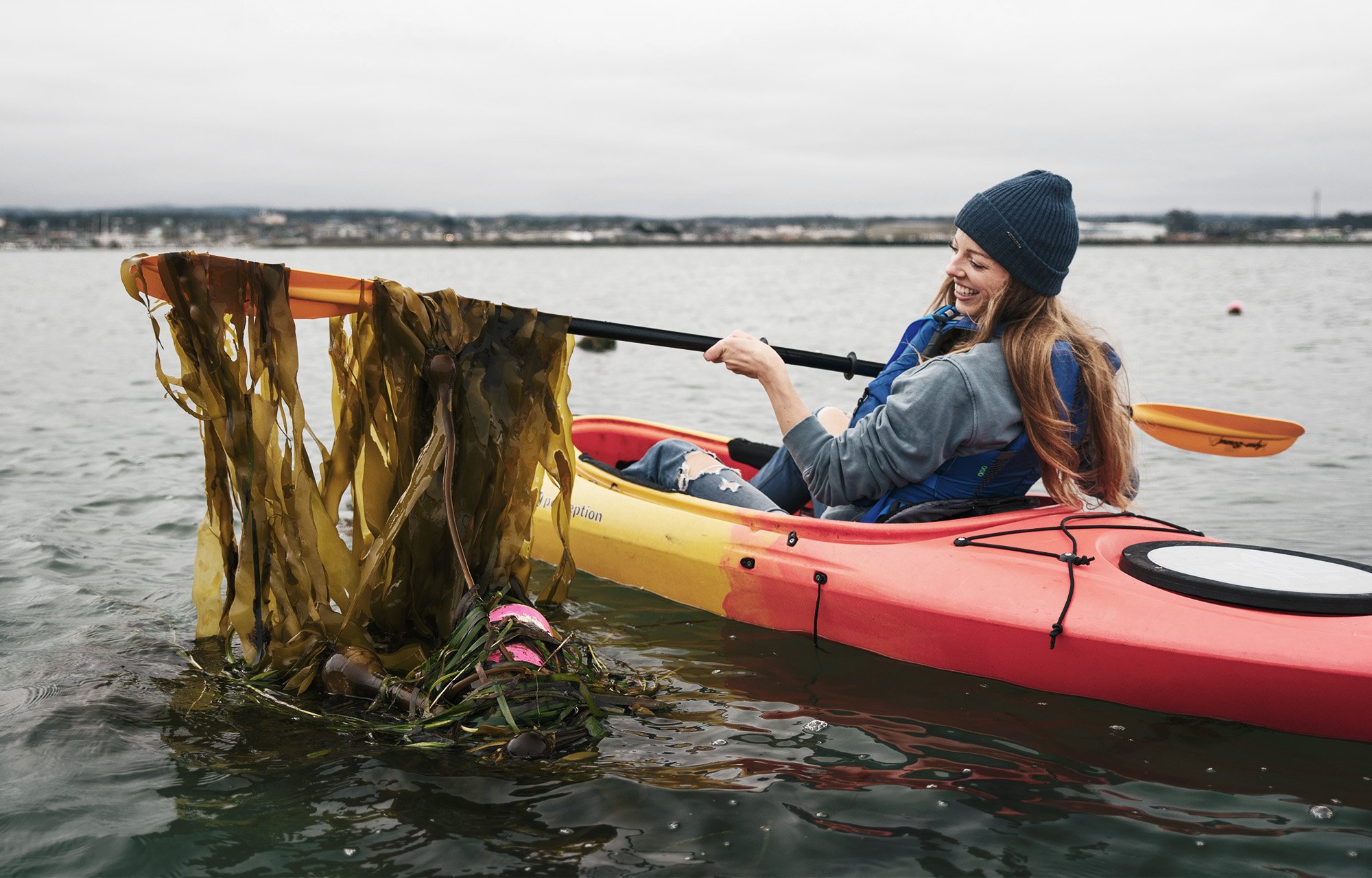How Sway is using seaweed to replace single-use plastic
We speak to Julia Marsh about her journey as a designer making ‘beautiful trash’ to being a CEO revolutionizing toxic food packaging
At Parley, we’re always thinking about the future. What can the world look like? How can it be improved? How can we not just live in harmony with nature, but learn from it? We are aware that we cannot simply recycle our way out of the plastic crisis – we need to redesign the structures and systems that pollute our planet, along with the harmful materials that we’ve become addicted to. It’s why we’re calling for a Material Revolution – we have to change the way we make things in order to create the future. This new Parley series will meet the innovators and scientists who are trying to remodel our material world.
Walk down the aisles of any supermarket in the world and you’ll be surrounded by single-use plastic packaging that keeps food fresh, only to be opened and discarded, never to be used again. This film cannot be recycled and so ends up incinerated, in landfills, or in our oceans, an end result that heavily contributes to a plastic pollution issue that the United Nations - and we - describe as a “planetary crisis”. But what if the answer to a problem that’s besieging our oceans had been in the water for around a billion years? Often, we find ourselves returning to nature for the answers.
Julia Marsh is the CEO of Sway, a California Bay Area-based startup that makes seaweed-based replacements for plastic. Their materials are designed to fit into existing plastic production systems and crucially, are made from a healthy, regenerative resource that decomposes back into the earth after use. Marsh started her career as a designer, but disenchanted with the wasteful products that she was making for brands she founded Sway in 2020, its name taken from the movement of seaweed in the water. Sway takes what are called polysaccharides from seaweed – agar, alginate and carrageenan – the natural polymers that make it so gelatinous and stretchy, to create replacement plastic products.
Recently, after three years of development, Sway announced the launch of its bio-based, compostable resin TPSea (Thermoplastic Seaweed) and, through partnerships with the plastic industry, aim to produce commercial volumes in 2024. Soon, your local shopping center might be full of seaweed, just not in the way you’re used to seeing it.
The theme for this year’s Earth Day is “Planet vs. Plastics” and so it felt like as good a time as any to speak to Marsh to dive deep on her crusade to provide healthy solutions to a material that’s causing havoc to marine ecosystems and human health. For the latest feature in our Material Revolution series we caught up with the Sway CEO to find out about her journey, consumer culture and why seaweed is a perfect replacement for plastic.
Julia Marsh
Q&A
I want to know about you and the journey that you've been on that led you to set up Sway. Was there a light switch moment that led you to founding the company and working with seaweed?
I am a designer by trade. I spent about ten years building brand and packaging systems for design studios, technology companies, startups and consumer brands, mainly in California, but also in New York and abroad. As a designer, I was making things beautiful, and that felt very important, but I was also making beautiful trash, things that you know are not going to have a long life. This work was sitting totally at odds with my upbringing growing up in the Monterey Bay area, home to Big Sur and Carmel, white sand beaches, redwood forests, and rich wetlands.
I know these natural systems are not benefiting from the creation of beautiful trash. It was that discomfort which led me to pursue a master's in design where I sought to not only create beautiful things, but to create work of consequence. I think designers are really qualified to make change because we can make, as my mentor Brian Collins says, “the impossible visible.” Impossible futures become visible thanks to design. I wanted to make an impossible future of truly circular materials, that came from nature and supported nature, visible to the world.
What do you love about working with seaweed as a material? And talk me through how it mimics plastic.
Looking at the existing alternatives for plastic derived from corn, potatoes, sugar cane and wood, I cataloged the reasons that when I pitched these materials to brands, I was hearing a ‘no’ back. It's because they're too expensive or they don't perform or they don't actually decompose or they're not actually really that plant-based. Maybe they're 10% corn and the rest is petroleum derived. So there are all these trade-offs that people felt they were making, and I thought the criteria for a true replacement would meet those shortcomings and then it would add value in addition, embodying the third pillar of the circular economy – regeneration, giving back, replenishing life. There's a lot of very cool feedstocks that do that, like coffee grounds, agricultural waste, cactus, SCOBY or mycelium. Seaweed is the most regenerative feedstock on Earth. It creates half of the air that we breathe, habitat for biodiverse life, and food for people on shore. It's also rich in natural polymers. I started exploring the aspects of seaweed's natural polymers that might plug into a plastic replacement that works at scale. I was curious how we could fit it into traditional manufacturing.
Single-use plastic is such a huge issue. Can you explain what parts of our plastic-obsessed system you see Sway products replacing?
There's a lot of packaging that is absolutely unnecessary. Personally, as a designer, I would prefer that packaging be minimized everywhere. Less is more. Where there's an opportunity for true reuse or true recycling, I think that's wonderful.
The areas that we're focused on are replacing the very annoying “necessary” plastics – flexible films that are typically used to maintain hygiene, or prevent damage like scuffing, ripping, tearing during shipping. Examples include polybags, retail bags, pouches, wrappers. The holy grail for us is food packaging, something like a Snickers bar wrapper would be the dream. This is a category of plastic that can't be recycled. It floats out of landfills into nature. It’s ubiquitous.
You talked earlier about brands saying no to things. What's the market response to your work been like – are people really coming round to the idea that things have to change?
Man, the answer is both. Every single person on earth is impacted by plastic waste and pollution. It's gross no matter who you are. So I think inherently all of us would like to not have to engage with plastic, or that icky feeling when you open up your Amazon package and it's just piles and piles of trash. The typical response to Sway packaging from consumers is, "Oh my gosh, how cool, is it really made from seaweed? Tell me more! Thank God you're doing this." Overwhelmingly that is the response.
The other side of the coin, is skepticism around the role compostable materials have to play – especially at a time when not everyone composts at home or has access to composting infrastructure. How do you speak to the consumer who doesn't really know that much about the difference between recycling and compostability? Maybe they think that sustainable solutions are dirty or inaccessible. How do we help people care about a new material? People want solutions, and know things have to change – but initially there will be confusion and I think that's where the big education opportunity is going to be.
“Seaweed is the most regenerative feedstock on Earth.
It creates half of the air that we breathe, habitat for biodiverse life, and food for people on shore.”
Julia Marsh — CEO of Sway
Amanda Guan — Materials Engineer at Sway
You're working with different seaweed farms around the world in places like Maine, the Dominican Republic, Chile, and Indonesia. Is there any difference in the material that you receive depending on location? And can you tell me about the different research projects that you're contributing to in these areas?
We have an agnostic approach to sourcing seaweed. There are about five commercially-scaled, farmed species of seaweed that we give preference to because we're trying to create a very consistent product that can be scaled to commercial volumes. However, we are constantly diversifying the types of seaweed we work with, both the species and the region that they're sourced from. This means that as we scale, we get to see a ripple effect in our sourcing strategy, creating a net positive for emerging blue economy zones. There is a difference in how different seaweed species perform. Some create films that are very stretchy, some create films that are more rigid, some add a color or texture, some don't. Depending on the species, there's optimization and reformulating that we have to do. But we're just scratching the surface, with thousands of seaweed species to choose from.
An example of how we're starting to explore less commercialized species is our project with Invest Puerto Rico and Newlab who have built a pilot program to use invasive sargassum washing ashore in Puerto Rico. Like in most regions in the Caribbean, these mass piles of sargassum are really causing problems for coastal communities. It's a health issue. It's also a tourism issue, it impedes on business. Sargassum is possibly the least charismatic seaweed species.
The pilot program is designed to connect every step of the supply chain – there's harvesters of sargassum who capture the seaweed before it arrives on the beach. There's processors that extract the valuable natural polymers from the sargassum, and then Sway uses that extracted polymer to create new materials. So far we have seen really wonderful results. Certainly there's a lot of scale up and optimization that needs to happen, but it's a great example of how “problem” materials can turn into a solution.
With TPSea, you've created a non-hazardous plastic replacement that can slot into existing plastic production systems, which is great. How long do you think it'll take for the product to truly scale from the pilot stage and what are the barriers you face with something like this?
There's a difference between scale and acceptance – scaling the product is not a challenge. We are already working on large-scale machinery with our partner plastic manufacturers. We're producing hundreds of pounds of TPSea resin per day just for our own trials and validation with customers. We have manufacturing partners and their capacity is already lined up for us to reach commercial volumes – we're talking thousands of metric tons. The challenge will be ensuring that TPSea, the seaweed resin, is being used in the right places where it makes sense for seaweed and a compostable material to be, and that people are willing, at least initially, to pay a little bit of a premium for it.
Is there enough seaweed in the world?
We live on a blue planet, 70% of the world is covered by ocean. As you can imagine, there’s a lot of seaweed! The number that's often cited in the seaweed world is from the Food and Agricultural Organization (FAO), which approximates there's about 35.8 million metric tons of seaweed farmed every year. This is not all the seaweed on earth, but just what's farmed for food and pharmaceuticals and use cases like ours. That number supposedly doubles every ten years. So is there enough seaweed in the world to replace all plastics? No. But is there a huge seaweed industry and enough seaweed to replace tons of plastic every year? Certainly. Growing in tandem with the industry responsibly is feasible as well.
You work with Fundación Rompientes in Chile, right? They’re a Parley partner too.
They are one of our 1% for the Planet partner companies! We love their model for embedding value into local communities, it's something we take a lot of inspiration from. In fact, it's important for people to know that we built our supply chain strategy before we built our product. The design mindset and the systems mindset says: if this scales, what actually happens? What is the actual impact for ecosystems and communities? We have a lot to learn and we're newcomers here. So groups like Fundación Rompientes are a great source of insight for ensuring that a regenerative value proposition is actually embedded from the beginning, and that coastal communities truly benefit from this new material revolution.
Have you noticed people's attitudes towards single-use plastic change over the past ten years?
Good question. I believe people's attitudes have changed but there's also the rise of e-comm and Amazon culture – this convenience of consumption – which has led to a lot of trash coming into people's homes. People are thinking about single-use plastic waste, especially bubble wrap and flexible films. There's so many examples of people taking photos and sharing online, "Why did I receive all this plastic garbage?"
People also have more access in public places to recycle and to compost – that's becoming increasingly normal. I think people have more options, and that makes them feel more receptive to change. What's your observation?
Well…people are happy to relentlessly order from Amazon, but those same people would probably wash out their Coke bottle and put it in the bin. The image of single-use plastic when it's a bottle or bottled water has become a bit gross. But at the same time, people haven't made the connection between hitting 'buy' on something that comes from Amazon and the trash that comes with that, or the idea of ordering clothes and ripping them out of the film, but then sending them back. Maybe attitudes have changed, maybe behaviors haven't changed enough.
You've just hit on another point which I find fascinating. People think of single-use plastic as bottles and straws. They don't think of flexible film. They think of grocery bags and they'll say, "Paper, not plastic", or bring a reusable bag, or they'll bring their reusable water container. But they're not thinking about how when they order from this beautiful sustainable brand online and it comes in a plastic pouch with another plastic pouch inside, how that is also single-use plastic consumption. Sometimes people are like, "Oh, I don't think that flexible film is an issue." And I say, "Please walk down the grocery aisle or open up your cabinet and you'll realize it's all there!"
I read that by 2040 plastic production will have doubled. Is there any way that we can combat that, beyond people like yourselves who are trying to design our way out of this issue?
It depends who the "we" is. The general public has more power than they think in pointing brands towards the solutions. If I order makeup on the internet and it arrives in a bunch of wasteful plastic, I can DM that beauty brand and write, "Hey guys, love the product, but could it come in a paper bag or maybe a Sway seaweed bag?” Giving them the inspiration to look at solutions is huge. Oftentimes the brand doesn't even know what the alternatives are. Not every brand has a sustainability person. If the customer says sustainability is desirable, and the design team can make the solution beautiful, and it tells a unique story, that's huge.
“Every single person on earth is impacted by plastic waste and pollution. It's gross no matter who you are.”
Julia Marsh — CEO of Sway
How long do you think it'll take before the planet isn’t producing any single-use plastic at all? And will that day come?
I don't think that day will come – though perhaps we will cease reliance on virgin plastic. More likely, I believe there will be a better marriage between materials and their assigned use case. What must happen is that responsibly sourced, biologically-derived materials become a part of the every day. Companies like mine, and adjacent ones like Bananatex or Cruz Foam, will make their way into the mainstream – but they'll be appropriately placed in applications where they makes sense. For example, aluminum makes sense in reuse systems, paper makes sense in recycling systems, and if plastic has a role, it'll be in places where both reuse and recycling are actually realistic. I think we're starting to see this evolving mindset.
Imagery courtesy of Sway, Alex Krowiak, and Business Insider.














